The next-gen MacBook Pro with Retina Display Review
by Anand Lal Shimpi on June 23, 2012 4:14 AM EST- Posted in
- Mac
- Apple
- MacBook Pro
- Laptops
- Notebooks
Last year when I wrote about the new MacBook Airs I offered two forward looking paragraphs:
What happens from here on out is what's really interesting. Intel has already committed to moving the TDP of its mainstream parts from 35W - 45W down to 10 - 20W. Since the Air is the new mainstream Mac notebook, Apple has already made that move. The performance in this 10 - 20W segment is going to get much better over the next two years, particularly once Haswell arrives.
The Thunderbolt Display is the first sign of what's to come. Moving IO controllers and expansion into the display, and potentially even moving discrete GPUs out of the notebook are all in store for us. Apple is really ahead of the curve here, but it's easy to imagine a future where laptops become a lot more like the new Air and shift to a couple high bandwidth ports instead of numerous lower bandwidth connections.
Perhaps I was being too aggressive in the prediction of a couple of high bandwidth ports. After all, the next-generation MacBook Pro with Retina Display features four such IO ports (2 x Thunderbolt and 2 x USB 3.0). But you get my point. Gigabit Ethernet and Firewire 800 are both gone. The discrete GPU is still present but I suspect even its days are numbered, at least inside the chassis. The personal computer as we knew it for so long, is changing.
The personal computer is getting thinner, lighter, more integrated and more appliance-like. The movement is no longer confined to just Apple either. The traditional PC OEMs are following suit. Even Microsoft has finally entered the PC hardware business, something it threatened to do for years but hadn't until now. Distribution models will change, the lines between different form factors will continue to blur. What was once a mature industry is going through a significant transformation. It’s exciting but at the same time it makes me uneasy. When I first got into this industry everyone had stories of companies with great ideas that just didn’t make it. As we go through this revolution in computing I’m beginning to see, first hand, the very same.
Apple makes the bulk of its revenue from devices that don’t look like traditional personal computers. For the past couple of years I’ve been worried that it would wake up and decide the traditional Mac is a burden, and it should instead be in the business of strictly selling consumer devices. With its announcements two weeks ago in San Francisco, I can happily say that my fears haven’t come true. At least not yet.
It’s been a while since Apple did a really exciting MacBook Pro launch. Much to my surprise, even the move to Sandy Bridge, the first quad-core in a MacBook Pro, was done without even whispers of a press conference. Apple threw up the new products on its online store, shipped inventory to its retail outlets, updated the website and called it a day. Every iPhone and iPad announcement however was accompanied with much fanfare. The MacBook Pro seemed almost forgotten.
With its WWDC unveil however Apple took something that it had resigned to unexciting, dare I say uncool status, and made a huge deal about it. Two weeks ago Apple did the expected and offered relatively modest upgrades to all of its portable Macs, all while introducing something bold.
Apple calls it the MacBook Pro with Retina Display. You’ll see me refer to it as the next-gen MacBook Pro, Retina MacBook Pro, rMBP or some other permutation of these words.
After using it for the past two weeks I can honestly say it’s the best Mac Apple has ever built. And there’s a lot more to it than hardware.
Portability
If you were hoping for a 15-inch MacBook Air, that’s not what the rMBP is. Instead it is a far more portable 15-inch MacBook Pro. I have to admit I was a bit let down the first time I laid eyes on the next-gen MacBook Pro, it looks good but it doesn’t look all that different. The disappointment quickly faded as I actually picked up the machine and started carrying it around. It’s not ultra light, but man does it make the previous chassis feel dated.
While I never really liked lugging around the old MBP (and it always made me feel like the old fogey at tradeshows where everyone else had something 13-inches or smaller), carrying the rMBP is a pleasure by comparison. Pictures really don’t do it justice. The impressively thin display assembly or overall chassis thickness look neat in a photo but it’s not until you actually live with the rMBP that you can appreciate what Apple has done here. I carry around a 15-inch MacBook Pro because it’s my desktop, and as such it’s incredibly useful to have with me when I travel. For my personal usage model, the Retina MacBook Pro is perfect.
If your workload demands that you need the performance of a MacBook Pro and your lifestyle requires you to carry it around a lot, the reduction in thickness and weight alone will be worth the upgrade to the rMBP. If you spend most of your time stationary however, you’ll have to be sold on the display and internal characteristics alone. The bad news is if the design doesn’t get you, everything else will.

From left to right: 11-inch MacBook Air, 13-inch MacBook Air, 15-inch MacBook Pro, MacBook Pro with Retina Display
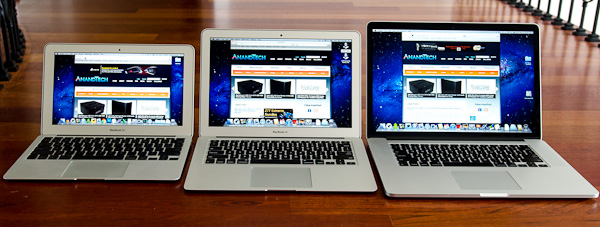
From left to right: 11-inch MacBook Air, 13-inch MacBook Air, MacBook Pro with Retina Display
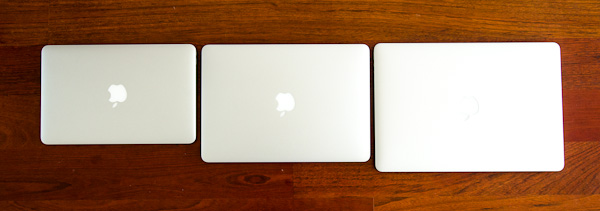
From left to right: 11-inch MacBook Air, 13-inch MacBook Air, MacBook Pro with Retina Display



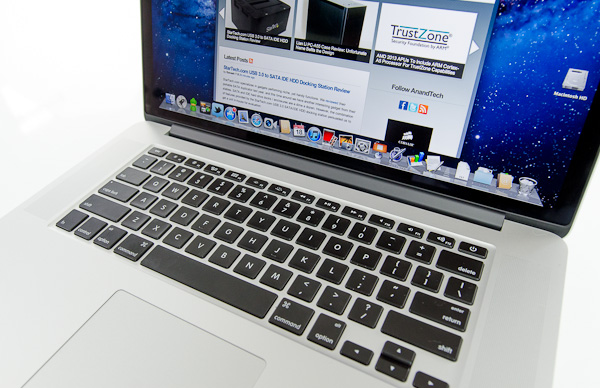
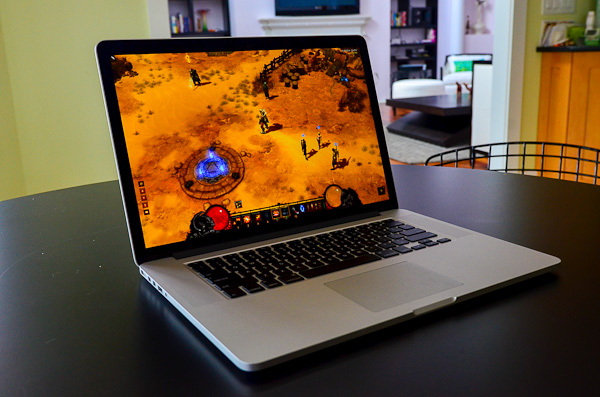
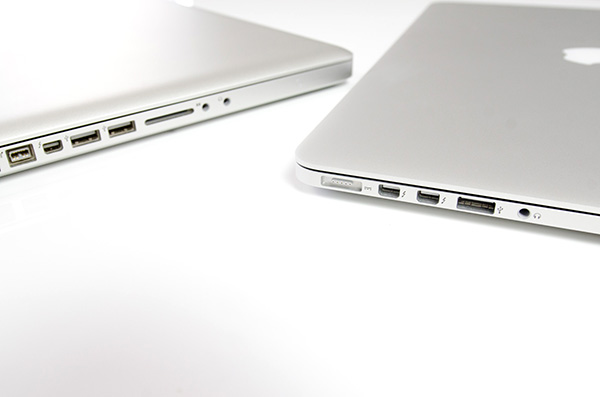
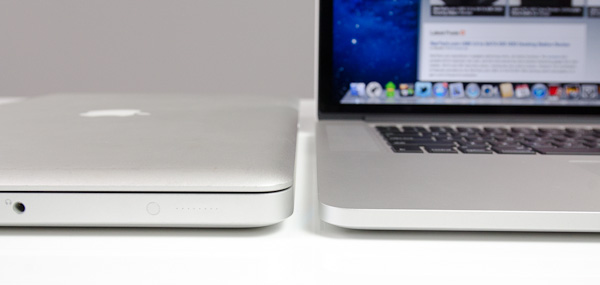








471 Comments
View All Comments
orthorim - Wednesday, June 27, 2012 - link
First of all, PC manufacturers are followers.Second even if they wanted to do it, how are they going to get Microsoft to fully support retina mode? It's evident from the review that Apple's had to do a lot of work on the software side to make it work, and it's still not perfect.
That's Apple's huge advantage: They make hardware and software.
The obstacle for a PC manufacturer would be:
- Get retina displays in quantity (same issue Apple faces - it's doable but by no means easy)
- Get Windows to support retina mode - even if MS were willing, no one knows what amount of effort would be involved. I guess it would be extremely hard to do.
- Get gfx card manufacturers to optimize their drivers to it's fast
All of this takes time and effort...
PubFiction - Friday, August 3, 2012 - link
None of you get it.Super resolution is a by product of OLED. Not of apple, not of anyone else. LG says they can make a panel and apple pays the highest price to have exclusive access fo a while. Are you guys really so stupid that you think apple actually makes these panels?
IF LG does not push IPS displays down in price and up in resolution OLED is quickly going to supplant LCDs as the premium product.
Let me make it clear to the sheeple, PC companies do not give a shit about you or giving you bette stuff until it becomes neccessary to maintain their business, apple happily sold everyone TN panels with low resolution for years while PC makers were offering IPS, wide gamut in work stations laptops.
gorash - Saturday, June 23, 2012 - link
Come on, 1080p screens have existed for some time, and obviously it would move to 4k at some point when it's ready. From the performance standpoint, "Retina" doesn't seem to be all that ready. Maybe in the next year or so, it will be.OCedHrt - Saturday, June 23, 2012 - link
Although the reviewers at Anandtech didn't really like the Z, it is the best laptop I have used to date.solipsism - Saturday, June 23, 2012 - link
Even if Apple can these 27" IPS panels made at a reasonable price and quantity you still have to deal with rending all the pixels in a way that adds more pros than cons.Remember 4k is 4x the pixels of 1080p. Taking the 27" from 2560x1440 to 5120x2880 is going from 3,686,400 px to 14,745,600 px.
DeciusStrabo - Saturday, June 23, 2012 - link
4k isn't 4x the pixels of 1080p. 4k is QFHD, which is 3840x2160 (6.1 million pixels vs. 2 million in 1080p).However, since we already have a spec for 8K (7680x4320 ~ 33 million pixels) things to indeed get interesting soon.
lukarak - Saturday, June 23, 2012 - link
3840x2160 = 8,294,400/
1920x1080 = 2,073,600
--------------------------------
2 x 2 = 4
DanNeely - Saturday, June 23, 2012 - link
4k is a lot more than just quadHD. I wouldn't be surprised if that ends up being the dominant mass market version; but most current 4k cameras record video at 4096x2304/2160.Ohhmaagawd - Saturday, June 23, 2012 - link
"emember 4k is 4x the pixels of 1080p. Taking the 27" from 2560x1440 to 5120x2880 is going from 3,686,400 px to 14,745,600 px."I really doubt it needs to double to be "retina".
Not sure what the sweet spot is, but my gut is somewhere around 3500-4000 pixels wide.
Acanthus - Saturday, June 23, 2012 - link
Apple and their forward looking business sense = buying every factory in the world that can produce high dpi displays. (Yes, they really did that)Anticompetitive =/= "forward thinking"